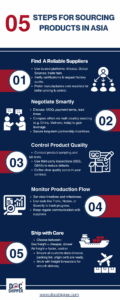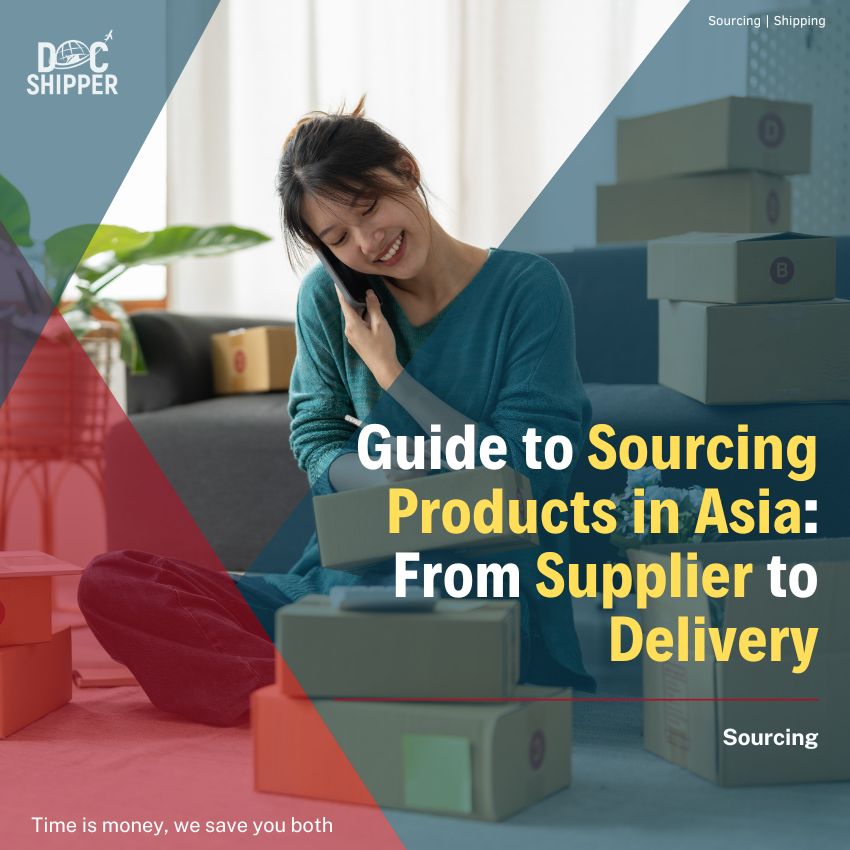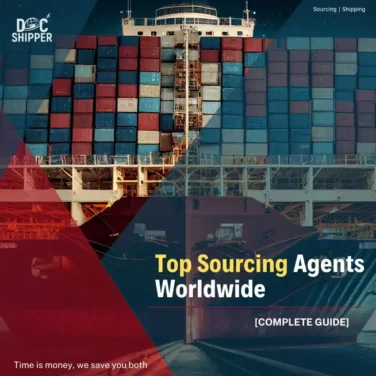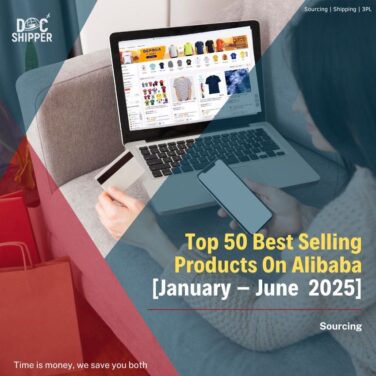In 2025, Asia will still be the top place to source all kinds of products, from electronics and clothes to everyday items. The Asia-Pacific region accounted for approximately 38.9% of global exports in 2024, reflecting its significant role in international trade. Businesses, big and small, count on the region because it offers good quality at affordable prices and lots of manufacturing choices.
While China remains important, countries like Vietnam, India, and Indonesia are growing fast, with better facilities and competitive costs. Whether you’re just starting out or looking to optimize your current supply chain, this comprehensive guide will walk you through every step of Sourcing products in Asia . From identifying trustworthy suppliers to navigating shipping logistics, this roadmap will help your business remain competitive and adaptable in today’s fast-changing global market.
What Does Sourcing Products in Asia Mean in 2025?

Sourcing products in Asia means: “ Partnering with manufacturers in the region to produce goods that meet your specifications, negotiating favorable terms, overseeing the production process, and arranging for delivery to your destination.”
In 2025, this process has evolved significantly. It’s no longer limited to just China. The “China+Many” strategy, spreading sourcing activities across multiple countries, is gaining traction as businesses seek to reduce risks and take advantage of each country’s unique strengths.
Technological advances have also revolutionized the sourcing landscape. With AI-powered platforms helping to match businesses with vetted suppliers and digital tools enabling real-time production tracking and remote quality checks, the process has become faster, more efficient, and more transparent. Asia continues to serve as the backbone of global manufacturing, providing the scale, diversity, and innovation that modern supply chains demand.
DocShipper Info
DocShipper Information : Did you know that by 2025, over 60% of global manufacturing output is expected to come from Asia, making the region indispensable for global supply chains ? Contact our experts today, and let us guide you through the future of Asian sourcing products in 2025!
Step-by-Step Guide to Sourcing Products in Asia
Step 1 – Identifying and Selecting Reliable Suppliers

Finding the right supplier is the foundation of successful sourcing. Start your search on trusted platforms like Alibaba, Global Sources, or industry-specific regional sites like EpicSourcing.
These platforms offer access to thousands of manufacturers, complete with reviews, certifications, and product catalogues.
Attending trade fairs like the Canton Fair in China or local expos in India, Vietnam, or Thailand can give you direct access to suppliers and allow you to inspect sample products firsthand.
One important step is distinguishing between factories and trading companies. While trading companies can offer flexibility and language support, working directly with manufacturers typically results in better pricing, more control over product specs, and faster communication. This distinction is especially critical in Asia, where many suppliers listed on sourcing platforms may appear as manufacturers but are intermediaries. Misidentifying them can lead to inflated costs, slower response times, and limited control over production.
Always vet your potential suppliers thoroughly. Request certifications such as ISO, BSCI, or SEDEX, and consider hiring third-party auditors to conduct factory inspections. These audits help verify a factory’s legitimacy, quality standards, and working conditions.
Reading client reviews, checking references, and examining sample products are also essential parts of the vetting process. This phase is often referred to as “supplier selection Asia” and sets the tone for a successful long-term partnership.
DocShipper Alert
DocShipper Alert : Many suppliers on platforms like Alibaba claim to be manufacturers, but are actually intermediaries. This can lead to inflated prices, poor visibility, and slower response times. Always confirm their business license and request a virtual or in-person factory audit. Contact DocShipper simplify your entire sourcing journey, from finding the right supplier to managing production, feel in the free form now.
Step 2 – Negotiating Terms and Pricing
Once you’ve shortlisted reliable suppliers, the next step is negotiating key terms. Important aspects to cover include Minimum Order Quantities (MOQ), pricing, payment terms (like 50% upfront and 50% upon delivery, or using letters of credit), production timelines, and after-sales service policies.
Transparency and clarity during these discussions are critical. Define product specifications clearly to avoid misunderstandings later. Additionally, consider multi-country sourcing in Asia to gain a strategic advantage. Comparing quotes from suppliers in Vietnam, India, and Indonesia can help you secure better deals and minimize your reliance on a single source.
It’s also significant to understand the cultural nuances of negotiation in different Asian countries. In some cultures, negotiations are straightforward, while in others, building relationships and trust takes precedence. Understanding these subtleties can improve your results and foster more collaborative partnerships.
Step 3 – Quality Control and Product Inspection

Maintaining product quality is non-negotiable. Begin with detailed samples that match your specifications. Outline every detail in your contract, from materials and dimensions to packaging and labelling. Implementing staged quality checks, during production, after production, and before shipping helps identify and resolve issues early.
Hiring third-party quality control agencies like SGS, Bureau Veritas, or QIMA can provide unbiased inspection reports. These services typically include factory audits, pre-production inspections, and final random inspections. Remote inspections using video and digital reporting tools are also becoming more common, especially for businesses that can’t travel frequently. This comprehensive approach ensures robust quality control in Asia sourcing.
Beyond inspections, invest in ongoing supplier development. Work with your suppliers to address recurring quality issues, improve production efficiency, and adopt better materials or processes. This not only ensures consistency but also fosters long-term improvements in your sourcing operations.
DocShipper Tip
DocShipper advice : Set clear product specs and include quality requirements directly in your purchase agreement to avoid disputes and delays later. Contact our team now to secure your sourcing process from the start !
Step 4 – Managing Production and Communication
Effective communication with your suppliers is key to keeping production on track. Use digital project management tools like Trello, Slack, Notion, or sourcing-specific platforms such as Sourcify to manage tasks, share files, and monitor timelines.
Set clear production milestones and ask for regular updates, including photos or videos from the factory floor. This transparency helps identify any issues early on. Be proactive in solving problems and maintain regular communication with key decision-makers. Always factor in extra time for unexpected delays like raw material shortages, labor disruptions, or shipping backlogs.
Asia sourcing agents can act as your in-country representatives, helping to resolve misunderstandings, enforce deadlines, and ensure that your expectations are met. They also serve as your eyes and ears on the ground, offering peace of mind and real-time insights into your production process.
Step 5 – Shipping and Delivery Options
Choosing the right shipping method depends on your timeline and budget. Sea freight is ideal for bulk orders as it’s more economical but takes longer. Air freight, while more expensive, is faster and better suited for high-value or time-sensitive items.
Regardless of the shipping method, ensure your paperwork is in order. You’ll need :
- commercial invoices,
- packing lists,
- certificates of origin,
- and possibly specific product testing documents.
Working with a reliable freight forwarder or customs broker can simplify customs clearance and ensure compliance with import regulations in your destination country. Smooth execution and document accuracy are crucial for timely delivery when shipping from Asia.
Consider additional logistics services like warehousing, consolidation, and last-mile delivery solutions if your supply chain includes multiple regions. These services add flexibility and help you streamline your overall product delivery Asia-wide.

Key Benefits of Sourcing Products in Asia
Sourcing from Asia provides a host of advantages that make it an attractive option for businesses around the world.
- Competitive Production Rates: Asian manufacturers offer competitive production rates. Bulk ordering and economies of scale further reduce per-unit costs without compromising on quality.
- Vast Product Assortment: From textiles and electronics to niche market goods, Asia provides access to a vast array of products, allowing businesses to diversify their catalogues easily.
- Scalability and Flexibility: With a large pool of suppliers, you can quickly increase or decrease your production volumes based on demand, market trends, or seasonal spikes.
- Risk Diversification: Multi-country sourcing in Asia minimizes risks associated with trade restrictions, political tensions, or natural disasters. A diversified supply chain is more adaptable to global disruptions.
- Innovation and Customization: Many Asian factories are equipped to develop custom products, support R&D, and accommodate new designs. This enables businesses to stay competitive and responsive to market demands.
Challenges When Sourcing in Asia and How to Overcome Them

While sourcing in Asia has many benefits, there are challenges that businesses must anticipate and address effectively:
- Communication Barriers: Differences in language and culture can lead to misunderstandings. Hiring bilingual sourcing agents or using professional translation tools is highly recommended to ensure smooth communication.
- Quality Control Issues: Not all suppliers maintain the same quality standards. It is crucial to thoroughly vet suppliers, request certifications, and engage third-party quality control agencies to safeguard against fraud and inconsistencies.
- Logistics Delays and Geopolitical Risks: Shipping delays or import restrictions can impact your operations. Diversifying suppliers across multiple countries helps reduce dependence on a single market and increases supply chain reliability.
To overcome these challenges, companies should partner with experienced sourcing agents, leverage trusted sourcing platforms, adopt digital tools to manage the process efficiently, and always have a contingency plan in place.
Emerging Trends in Asia Sourcing for 2025
The landscape of sourcing in Asia is changing rapidly, driven by several key trends:
- Emergence of Alternative Sourcing Hubs: Countries like Vietnam, India, and Indonesia are investing heavily in infrastructure and offering favorable trade policies, becoming increasingly popular alternatives to China for many product categories.
- Technological Advancements in Sourcing: AI-powered tools are revolutionizing supplier discovery, helping companies find the best partners based on performance, location, and capabilities. These platforms also offer real-time production tracking and integrated quality checks, significantly enhancing the efficiency of Asian sourcing.
- Growing Emphasis on Sustainability and Ethics: More businesses are prioritizing eco-friendly practices and supplier transparency. Ethical labor, reduced carbon footprints, and the use of sustainable materials are becoming standard expectations across supply chains.
- Adoption of Hybrid Sourcing Strategies: To balance resilience and responsiveness, some businesses are adopting a hybrid approach. This blends traditional Asian sourcing with near shoring options to reduce lead times and respond more quickly to market changes.
DocShipper Tip
Docshipper Tip : Not sure which sourcing hub fits your product best? Each country in Asia has its own strengths ; Vietnam for electronics, India for textiles, Thailand for wellness goods ! Ask our experts to match your needs with the right country and supplier. It could save you months of research and thousands in production costs.
Case Studies: Successful Sourcing from Asia

To better understand the real-world impact of strategic sourcing, here are three case studies showcasing how companies successfully leveraged suppliers in Asia to reduce costs, improve efficiency, and boost profit margins :
Case Study 1: “TechPulse Innovations” – Electronics (Vietnam)
TechPulse Innovations, a Berlin-based startup, faced rising production costs for their smart home devices due to their single Chinese manufacturer. By late 2023, their per-unit cost had climbed 18%.
They partnered with “Vietronix Manufacturing” in Hanoi, Vietnam. Within 9 months, TechPulse cut their per-unit production cost by 25%, saving an estimated €1.2 million annually. Product quality remained consistent (less than 0.5% increase in warranty claims), and they diversified their supply chain, reducing reliance on China.
Case Study 2: “Veridian Threads” – Organic Textiles (India)
UK-based eco-fashion brand Veridian Trading struggled with long lead times and inconsistent quality from their fragmented organic cotton fabric supply.
They streamlined their sourcing by collaborating with “Gaia Eco-Textiles,” a GOTS-certified mill in Gujarat, India. This partnership shortened fabric lead times by 15% (from 12 to 10 weeks), allowing them to launch new collections 3 weeks faster. Their fabric rejection rate dropped by over 40%, and their enhanced sustainability credentials contributed to a 5% increase in customer loyalty.
Case Study 3: “Global Bloom” – Consumer Goods (Thailand)
New York-based dropshipping company Global Bloom needed to find unique, high-margin products to stay competitive.
They identified a growing demand for natural wellness items and sourced them from small to medium-sized manufacturers in Thailand. This strategy led to an average 20% increase in profit margins across their Thai wellness line, boosting overall company profit by approximately $150,000 annually. The new category grew sales by 35% year over year, allowing them to diversify their product range and build strong supplier relationships.
Conclusion
Sourcing products in Asia in 2025 is about more than just finding the lowest price. It’s about building smart, flexible supply chains that can adapt to market changes, consumer demands, and global events. With the right approach and partners, businesses can reduce costs, boost efficiency, and drive sustainable growth.
At DocShipper, we specialize in guiding businesses through every step of the sourcing journey, from finding and vetting suppliers to managing production and arranging delivery. Our all-in-one service simplifies international trade and helps you make the most of Asia’s vast manufacturing landscape.
FAQ | Guide to Sourcing Products in Asia: From Supplier to Delivery
DocShipper Info
DocShipper Information : Did you like this article? You may also like the following :
- 2025 Guide: 6 Mistakes to Avoid in Pre-Shipment Inspection, May 12, 2025
- How To Buy Wholesale: Your Ultimate 2025 Guide, April 9, 2025
- Canton Fair 2025: Your Essential Gateway to Chinese Markets, April 4, 2025
- Top 20 Shanghai wholesale markets to Explore in 2025 April 3, 2025









